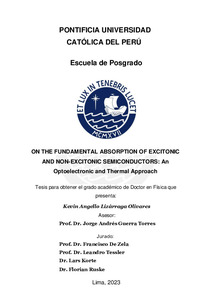| dc.contributor.advisor | Guerra Torres, Jorge Andrés | |
| dc.contributor.author | Lizárraga Olivares, Kevin Angello | |
| dc.date.accessioned | 2023-08-28T17:49:52Z | |
| dc.date.available | 2023-08-28T17:49:52Z | |
| dc.date.created | 2023 | |
| dc.date.issued | 2023-08-28 | |
| dc.identifier.uri | http://hdl.handle.net/20.500.12404/25793 | |
| dc.description.abstract | In thepresent work, we study the optical properties of semiconductors near the fundamental absorption taking into account disorder induced tail states. In particular, we pay special attention to GAAs and lead halide perovskites. We address existing models for the description of the absorption spectra, and extend them in the band fluctuations framework. We start with traditional semiconductors where we have developed our models inspired in Jellison-Modine procedure (Tauc-Lorentz model).These models are tested on direct,indirect and amorphous band gap materials such as the ones of the group III −V family. Later, we continue the discussion with the inclusion of the Sommerfeld enhancement factor for understanding the nature of excitonic semiconductors. Here, the Elliott model is modified through the band fluctuations procedure in order to obtain an analytic expression for the imaginary part of the electrical permittivity. This new model accurately describes the band gap and binding energy of systems like GaAs,MAPbBr3, MAPbI3 and MAPbI3−xClx. Furthermore,the impact of the sample temperature on optical parameters such as the band gap can provide information regarding the thermal expansion and th eelectron-phon on interaction in the solid. In particular,if the material exhibits a high electron-phon on coupling,like in the cases of the polar semiconductors, the model describing the exciton can no longer rely on the Hydrogen-like picture, but instead it must be computed with a theory considering exciton-polarons. In the latter case, the exciton is dressed by a cloudofphonons that lower its binding energy. Remarkably, our model for excitonic materials correctly predicts the exciton-polaron binding energies of lead halide perovskites andt heir carrier’s effective massees. Lastly, we emphasize the powerful relation between the optical properties and the thermal properties. Notably, we found a good agreement among our predicted expressions,using the Debye’s model, with other specific heat experimental results. | es_ES |
| dc.language.iso | eng | es_ES |
| dc.publisher | Pontificia Universidad Católica del Perú | es_ES |
| dc.rights | info:eu-repo/semantics/openAccess | es_ES |
| dc.rights | Atribución-CompartirIgual 2.5 Perú | * |
| dc.rights.uri | http://creativecommons.org/licenses/by-sa/2.5/pe/ | * |
| dc.subject | Semiconductores--Propiedades ópticas | es_ES |
| dc.subject | Semiconductores--Propiedades térmicas | es_ES |
| dc.subject | Arseniuro de Galio | es_ES |
| dc.subject | Absorción | es_ES |
| dc.title | On the fundamental absorption of excitonic and non-excitonic semiconductors: an optoelectronic and thermal approach | es_ES |
| dc.type | info:eu-repo/semantics/doctoralThesis | es_ES |
| thesis.degree.name | Doctor en Física | es_ES |
| thesis.degree.name | Doctor en Física | es_ES |
| thesis.degree.level | Doctorado | es_ES |
| thesis.degree.grantor | Pontificia Universidad Católica del Perú. Escuela de Posgrado | es_ES |
| thesis.degree.discipline | Física | es_ES |
| thesis.degree.discipline | Física | es_ES |
| renati.advisor.dni | 46163725 | |
| renati.advisor.orcid | https://orcid.org/0000-0002-1734-6660 | es_ES |
| renati.author.dni | 73312302 | |
| renati.discipline | 533018 | es_ES |
| renati.juror | De Zela Martinez, Francisco Antonio | es_ES |
| renati.juror | Guerra Torres, Jorge Andres | es_ES |
| renati.juror | Korte, Lars | es_ES |
| renati.level | https://purl.org/pe-repo/renati/level#doctor | es_ES |
| renati.type | https://purl.org/pe-repo/renati/type#tesis | es_ES |
| dc.publisher.country | PE | es_ES |
| dc.subject.ocde | https://purl.org/pe-repo/ocde/ford#1.03.00 | es_ES |







